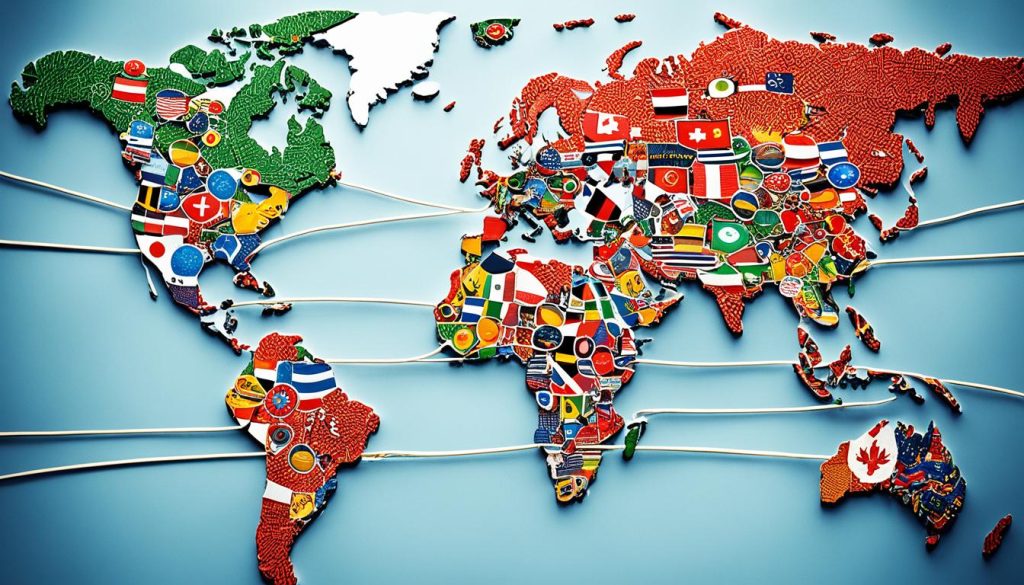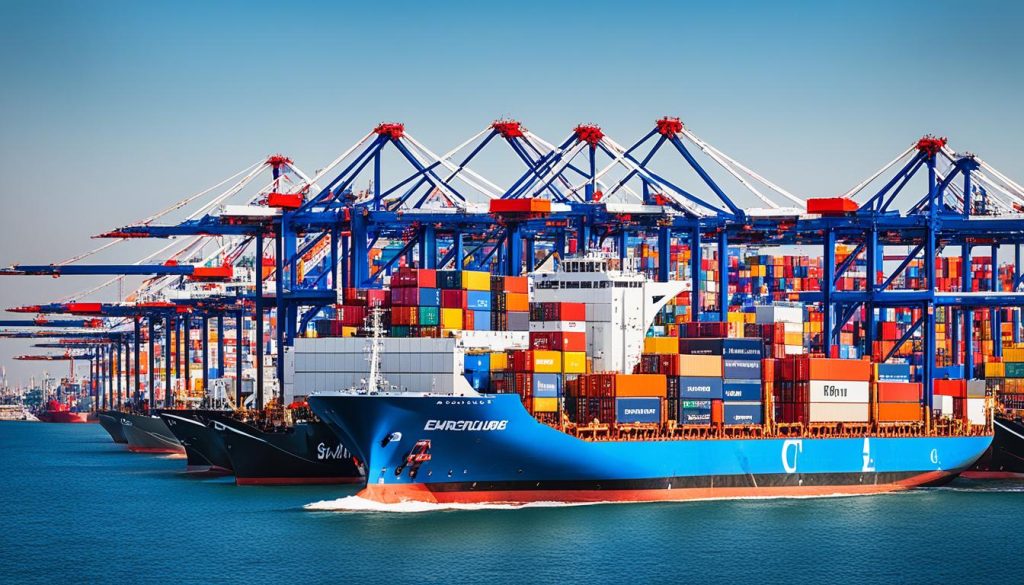In today’s connected world economy, big companies called Multinational Enterprises (MNEs) are vital. They help with economic growth and world trade. These enterprises bring together markets, cultures, and industries from around the globe.
This piece will look into the different MNE types. We aim to give you a deep understanding of their importance and how they work.
Multinational corporations are split into four main types: Global, Transnational, International, and Multidomestic. Each one has its own way of doing things and special strategies. They use these to do well in the global business world. By looking at these types, we get to see their role in economic enhancement more clearly.
Key Takeaways
- Multinational corporations are crucial for connecting global economies and fostering international trade.
- MNE categories include Global, Transnational, International, and Multidomestic enterprises.
- Each type of MNE has distinct characteristics and strategies that enable their success in global markets.
- Understanding these categories helps in appreciating the diverse nature of global business entities.
- Multinational enterprises significantly contribute to economic development and global integration.
Introduction to Multinational Enterprises
Multinational enterprises (MNEs) play a big role in international business. They operate in many countries. These firms are key to bringing countries closer through business. They find new ways to do things, which helps grow the world’s economy.
What makes MNEs special is how they work in different places. They help the economies where they are. They cut costs and reach more customers by doing business in many countries. This helps them grow, and it helps the economy too. They also know how to work with different countries’ rules, which is very important.
In the world of international business, MNEs use smart strategies to stay ahead. This piece talks about these strategies. It shows how MNEs shape our global economy.
These companies are very important for creating new things. They use talent and technology from around the world. This way, they come up with smart solutions. They push industries to innovate, helping the economy everywhere.
This part starts our look into how these companies work. We will look at their operations and strategic plans. MNEs show the exciting changes in international business.
Importance of Multinational Enterprises in Global Trade
Multinational enterprises (MNEs) play a key part in global trade. They fuel economic growth, spur innovation, and spread new technologies worldwide.
Economic Impact
MNEs boost economic growth by setting up in multiple countries. This brings lots of benefits to local economies. They create jobs, share technology, and increase investment.
By being in international markets, they make competition stronger. This improves productivity and how companies operate.
The table below showcases the various economic contributions of MNEs:
| Economic Contributions | Example |
|---|---|
| Job Creation | Apple Inc. employs over 1.6 million people globally through its direct operations and supply chain. |
| Technology Transfer | Samsung facilitates technology advancements in host countries, enhancing local industries with its cutting-edge research and development centres. |
| Investment Flows | Unilever invests significantly in emerging markets, supporting local infrastructure development and economic progress. |
Political Influence
MNEs have a big say in global politics and trade rules. They work with governments to shape trade agreements and regulations. They help build international relationships and cultural ties.
Companies like Nestlé and Toyota help shape trade policies. They strengthen economic connections between countries. Their wide reach promotes cooperative international trade.
Key Characteristics of Multinational Enterprises

Understanding how multinational enterprises (MNEs) work is key. They operate efficiently worldwide thanks to certain features. These include their complex structures, strong financial results, and dynamic HR strategies.
Operational Characteristics
Multinational companies have a sophisticated setup designed for worldwide operations. They have a main hub to plan global strategy. Then, local branches adapt to each country’s needs and rules. Tech and teamwork across borders help them stay flexible and quick.
Financial Characteristics
Great financial performance sets successful MNEs apart. They earn money in many markets, which reduces their risks. To keep doing well financially, they use a mix of funding options and smart tax strategies. This approach boosts their profits and efficiency.
Human Resources Policies
The way MNEs handle HR is vital to their success. Their HR policies are flexible and welcoming, covering a team from all over. They aim to create a workplace that values everyone’s views. They also offer training to help employees excel worldwide.
Four Types of Multinational Enterprises
Let’s dive into the world of multinational enterprises by exploring their distinct types. We have global companies, transnational organisations, international firms, and those with a multidomestic strategy. Understanding these will shed light on their unique methods and strategies for navigating global markets.
- Global Companies: They make decisions from the centre and aim for efficiency. They do this by keeping their practices the same all over the world. These companies usually do not change their products much, keeping their brand the same wherever they go.
- Transnational Organisations: These entities mix global and local ways by sharing resources across borders. They also pay attention to what local people need. Transnational organisations find a balance, using a global resource pool but making decisions in a more spread-out way.
- International Firms: These firms take their products and services overseas with little change. Their approach is to use what they do well at home to grow internationally.
- Multidomestic Strategy: Companies using this strategy adapt their offerings for every market they enter. They spread out their operations to be more flexible and meet the unique wants of local customers, focusing on what works best in each place.
Each of these categories shows how multinational enterprises operate internationally in their unique ways. Choosing to operate as a global, transnational, international firm, or using a multidomestic strategy depends on many things. These include what customers want, the competition, and what the company itself can do best.
This table helps us compare the main features of each multinational enterprise type:
| Type | Decision-Making | Local Responsiveness | Resource Allocation |
|---|---|---|---|
| Global Companies | Centralised | Low | Standardised |
| Transnational Organisations | Balanced | High | Shared |
| International Firms | Mainly Centralised | Moderate | Leverage Home Capabilities |
| Multidomestic Strategy | Decentralised | Very High | Tailored to Local Markets |
Global Multinational Enterprises: Characteristics and Examples
Global Multinational Enterprises (MNEs) are key players in the international scene. They aim to reach the entire globe with their products and strategies. Let’s look at what makes them tick and celebrate their achievements.
Identifying Features
Key features make global MNEs stand out. One main feature is their focus on the same products wherever they go. This means they keep quality and branding the same in every place. It helps people recognise their brand easily and saves money in making their products.
These enterprises work all over the world, making the most of their broad presence. They also use the same marketing ideas in every country. This makes sure their brand looks and feels the same everywhere.
Case Studies
Let’s learn from real examples of global MNEs. Take Coca-Cola, for instance. Its taste, look, and adverts are the same worldwide. This makes its brand known and loved all over.
Apple Inc. is another great example. Its products and adverts keep the same style everywhere. This approach has won Apple fans all over the world and made their operations smooth.
| Company | Standardised Products | Uniform Marketing | Worldwide Reach |
|---|---|---|---|
| Coca-Cola | Consistent flavour and packaging worldwide | Global advertising campaigns | Presence in over 200 countries |
| Apple Inc. | Uniform product design | Seamless global marketing strategies | Extensive global sales network |
These stories show how global MNEs shine by keeping things uniform. With their unified marketing and products, they have conquered markets all over the world.
Transnational Multinational Enterprises: Characteristics and Examples

Transnational multinational enterprises (MNEs) combine global efficiency with local adaptability. They use a special organisational setup. This blends resources across borders while staying in tune with local needs.
Identifying Features
Transnational MNEs balance global and local needs with unique features. Let’s discuss their key characteristics:
- Hybrid Organisational Structure: These businesses use a mix of central and local management. This helps them handle worldwide tasks and meet local demands.
- Local Responsiveness: They build strong local connections. This means they can meet local tastes, follow laws, and understand cultural differences well.
- Global Integration: Through global integration, transnational MNEs efficiently use resources. They maintain a united brand and run smooth supply chains crossing many countries.
Transnational MNEs find the perfect mix with their hybrid structure. This balance boosts their global and local strengths. It sets them up for long-term success in various markets.
International Multinational Enterprises: Characteristics and Examples
International Multinational Enterprises (MNEs) are different from other types of corporations. They focus mainly on an export-based strategy and control their operations from their home country. This approach means they use very little foreign direct investments, preferring to use subsidiaries or exports to enter new markets.
Identifying Features
International MNEs have unique features:
- Their management is centralised in the home country.
- Exports are their primary way to enter markets.
- They engage less in cross-border management activities.
- They make minimal investments in overseas subsidiaries.
Case Studies
Looking at famous brands shows how International MNEs operate:
| Brand | Export-Based Strategy | Use of Foreign Direct Investments |
|---|---|---|
| Nike | Uses exports to reach worldwide markets. | Minimal, focuses on partnerships. |
| Coca-Cola | Depends on exporting and strategic exports. | Small investments in local marketing and distribution. |
These examples show that International MNEs grow globally with few direct investments. They highlight the role of an export-based strategy and effective cross-border management.
Multidomestic Multinational Enterprises: Characteristics and Examples
Multidomestic Multinational Enterprises (MNEs) customise their strategies for each country. They match their products and services to local tastes, traditions, and buying habits. Understanding what people in different regions prefer requires thorough market research. This ensures they meet consumer needs and trends more accurately.
Identifying Features
Multidomestic MNEs are known for their decentralised management. This setup lets local branches make their own decisions based on what works best locally. They quickly adapt to consumer needs and market shifts. This method enables them to be flexible and speedy in their response.
- Local Customisation: Products and services are specifically tailored to meet local tastes and preferences, leading to regional variations.
- Decentralised Management: Each subsidiary operates independently, making strategic decisions suitable for their specific market.
- Country-Specific Approach: The business strategies and operational tactics are crafted based on the unique attributes of each local market.
Companies like McDonald’s and Unilever show how this approach works. McDonald’s changes its menu to appeal to local tastes across countries. Unilever adjusts its products for different market needs. Their global success highlights the power of focusing on local needs and preferences.
Strategic Roles of Global Multinational Enterprises
Global multinational enterprises (MNEs) play a vital role in pushing innovation forward. They do this while keeping a competitive edge. They shine in two main areas: research and development (R&D) and managing global supply chains. These firms help distribute products worldwide and make operations smoother. This is key to their great success.
Research and Development
Global MNEs lead the charge in R&D efforts. They pour a lot of resources into coming up with new ideas. They set up advanced R&D centres around the globe. Here, they work on the latest technology that moves industries ahead. Giants like Google and Tesla show how big investments in R&D pay off. These moves don’t just boost their growth but also help the world innovate.
Global Supply Chains
Having effective supply chains is essential for MNEs. Companies such as Apple and Amazon have created high benchmarks. They’ve perfected how they distribute products across the globe. Their strong supply chains mean products reach far-off markets quickly and without costing too much. Below is a table showing how well-planned supply chains benefit global MNEs:
| Attribute | Benefit | Example |
|---|---|---|
| Integrated Technology | Improved tracking and management | Amazon’s AI-driven logistics |
| Diverse Supplier Base | Less risk and more resilience | Apple’s global component sourcing |
| Scalability | Quickly meets global demand | Zara’s fast inventory turnover |
Strategic Roles of Transnational Multinational Enterprises
Transnational multinational enterprises (MNEs) handle complex situations with great skill. They balance global needs and local demands well. This balance helps them adapt to different markets while keeping a unified global operation. They also share knowledge across borders, which brings new ideas and keeps them ahead in their field.
These enterprises use flexible strategies to work well in different rules and cultures. They use top-notch communication tech and management systems to share info and resources easily. This ability makes them more agile and tough against competitors worldwide.
- Global Integration: Transnational MNEs unite their operations across countries. This ensures they keep consistent standards everywhere.
- Local Responsiveness: They adjust their methods to fit the unique needs of local markets. This shows how flexible they can be.
- Innovation through Knowledge Transfer: By sharing knowledge across borders, these enterprises stay innovative. This boosts their chance to lead in their industries.
Given their important roles, transnational MNEs are key to the world’s economy. Their ability to change and succeed in different scenarios shows their strategic strength. Their dedication to sharing knowledge and staying competitive is vital for their success.
| Strategic Role | Benefits |
|---|---|
| Global Integration | Ensures consistent global standards |
| Local Responsiveness | Adapts to local market conditions |
| Knowledge Transfer | Encourages innovation and improvement |
Strategic Roles of International Multinational Enterprises
International Multinational Enterprises (MNEs) are crucial in the global market. They use specific strategies to grow worldwide. We will look into their strategic roles, like expanding markets, adapting to cultures, and examining different case studies.
Market Expansion
Market expansion is vital for international MNEs. They aim to enter new areas through effective strategies. Samsung and Honda are examples of companies that have grown their operations worldwide. They did this by understanding local markets and consumer behaviour.
These MNEs plan carefully to enter new markets. They consider the market’s size, the competition, and rules to ensure they grow sustainably.
Cultural Adaptation
Adapting to local cultures is key for MNEs’ success. It’s essential when designing products, marketing, and operations that fit with local preferences. McDonald’s, for example, changes its menus to match regional tastes, showing how well they adapt to local markets. This approach builds brand loyalty and avoids cultural misunderstands.
Comparative Case Studies
Comparative studies help understand MNEs’ strategies in market expansion and cultural adaptation. Take Starbucks and Unilever as examples. Starbucks merged Western coffee culture with Chinese traditions. Meanwhile, Unilever adjusted its brands to meet local needs in various regions. This shows how MNEs manage their global brand while adapting to local markets, boosting their competitiveness and market share.
Summarising, international MNEs combine market strategies and cultural intelligence to succeed abroad. Their success depends on how well they can adapt and integrate these strategies globally.
Strategic Roles of Multidomestic Multinational Enterprises

Multidomestic Multinational Enterprises (MNEs) use local knowledge to fine-tune offerings. They tweak their products and services for each region. This focus strengthens their position in markets and keeps customers happy by meeting unique cultural and consumer demands.
These MNEs have a decentralised structure which gives power to local managers. It allows them to make decisions that fit their market perfectly. This strategy promotes independence, sparking innovation and a strong entrepreneurial drive at the local level.
Being free to act independently helps these firms quickly adjust to new market trends and rules. This flexibility makes them nimble, helping them change strategies to match local needs. It’s key to their success, boosting profits and market response.
The strategic use of local knowledge, managerial power at the subsidiary level, and the freedom to make region-specific decisions are key. These strategies are shown in the table below:
| Aspect | Benefit | Example |
|---|---|---|
| Local Market Expertise | Enhanced product and service relevance | Unilever’s regional product variations |
| Subsidiary Empowerment | Greater innovation and quicker decision-making | Nestlé’s decentralised management approach |
| Regional Autonomy | Swift adaptation to local market changes | McDonald’s regional menu customisations |
Multidomestic MNEs show us that local insight, empowering managers, and regional freedom are big plusses. They create a strong base to soar in the varied and fast-paced global market.
Future Trends for Multinatural Enterprises
As we step into the future, multinational enterprises (MNEs) face a world full of changes and surprises. They must adapt to new ways of doing business, changing how they operate and reach their customers. Companies like Microsoft and Amazon show us how it’s done. They use new technologies to change their industries and grow.
Artificial intelligence (AI) and machine learning are becoming key tools for MNEs. These technologies help them understand what customers want, make better decisions, and create new things. For example, Google uses AI to make its searches better and help in healthcare.
At the same time, MNEs are focusing more on being sustainable. This is because they have to meet new rules, customers want it, and it’s important for the planet. Companies such as Unilever and Tesla are leading by showing that making money and being green can go hand in hand. This shows that MNEs need to think about sustainability to stay competitive and relevant.
Also, working together globally is becoming more important. MNEs need to work with different groups like governments, NGOs, and local communities. This helps create a fairer and more collaborative world. The United Nations is pushing for this through its Sustainable Development Goals (SDGs).
In conclusion, MNEs have a big job ahead. They need to keep changing how they do business, use new technologies, be sustainable, and work with others globally. These steps are crucial for them to succeed in our fast-changing world.
















